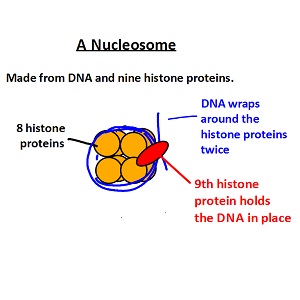DNA structure - Extras for HL
 This lesson introduces students to nucleosomes, and some of the details of DNA structure which will help to understand DNA replication. This includes the purine and pyrimidines bases as well as 5' and 3' notation of the ends of DNA strands. A simple powerpoint and some structured notes sheets help teachers and students alike. There is also a simple modeling task to help visualise the nucleosome.
This lesson introduces students to nucleosomes, and some of the details of DNA structure which will help to understand DNA replication. This includes the purine and pyrimidines bases as well as 5' and 3' notation of the ends of DNA strands. A simple powerpoint and some structured notes sheets help teachers and students alike. There is also a simple modeling task to help visualise the nucleosome.
Lesson Description
Guiding Question
Biological terms with simple meanings sometimes look daunting, what do these long words describing DNA actually mean in simple terms,
- "Purine",
- "Pyrimidine",
- " 3' and 5' ",
- "antiparallel strands"
- "nucleosome"
- "histone ocamer"?
Activity 1 - Extra details about DNA structure
Watch this ![]() short presentation about DNA structure for an introduction to nucleosomes, purines pyrimidines and the 5' and 3' ends of DNA strands.
short presentation about DNA structure for an introduction to nucleosomes, purines pyrimidines and the 5' and 3' ends of DNA strands.
Students can use this ![]() Nucleosomes and DNA student sheet to make notes.
Nucleosomes and DNA student sheet to make notes.
(click the eye icon to display it)
Activity 2: Modeling nucleosome structure using modeling clay and pipe cleaners
Carry out the activity to model the structure of a nucleosome below.
Make eight equal sized (1cm diameter) balls of Plasticine
Arrange them them together into a cube shape.
Twist two pipe cleaners into a double helix shape and wrap them round the cube shape from step one. Make sure they form two complete turns of the core.
Make a small ninth Plasticine shape and use this to fix the overlapping ends of the pipe cleaners.
This makes a simple model of a nucleosome.
Activity 3 Using visualisation software
There are some excellent 3D renderings of nucleosomes available.
Click the image below to open the linked page where you can rotate a histone molecule and see the way DNA coils twice around the histone proteins of the nucleosome.
Use the PDB gallery interactive on Nucleosome Structure by David Marcey shown above to answer the following questions.
Answer the following questions:
- How many histone proteins make up the core of the nucleosome?
- how many different types of histone proteins make up the core?
- How many nucleotide bases are found in the DNA which wraps around the histone protein core?
- What is the role of the ninth histone protein?
Click the icon to display some model answers
Model answers
- How many histone proteins make up the core of the nucleosome?
Eight - how many different types of histone proteins make up the core?
Four - called imaginatively H2A, H2B, H3 and H4 - How many nucleotide bases are found in the DNA which wraps around the histone protein core?
146 base pairs are wrapped around the core. - What is the role of the ninth histone protein?
The ninth histone protein (H1) wraps another 20 base pairs and binds the DNA to the histone proteins.
Extension reading
Read about how the nucleosome structure helps epigenetics to control gene expression in these articles:
The Illustrated guide to Epigenetics by Joe Kloc on Mother Jones
A good easy to read article in the Guardian newspaper: Epigenetics101
There is a good illustrated explanation of epigenetics in the NYTimes for those who prefer to avoid long texts:
For enthusiasts
There are links to several videos about epigenetics on the IHEC website.
Teachers notes
Although some of the details or DNA structure mentioned in the presentation in activity one, they are concepts which will be mentioned in DNA replication. They are included for this reason.
The first activity is a simple descriptive presentation with a sheet on which students can make notes.
A good conclusion to activity 1 might be a short video. There are some excellent DNA videos to remind students of the HL details. The Structure of DNA from MITx Bio is detailed and very clear.
This short animation shows DNA coiling round nucleosomes, and supercoiling to form chromatin.
It is just 5 minutes and concludes with a short introduction to epigenetics. From Supercomputational Life Science
http://www.scls.riken.jp/en/
These visualisations also show formation of nucleosomes, but then go on to illustrate DNA replication. A good link to the next topic perhaps, from WEHI-TV Animations
Activity 2 takes a few moments to build a simple model of a nucleosome which will help students to visualize the drawings
The third activity goes on step further, using an online visualisation tool to see the closest model of nucleosome structure we have.
If you have a 3D printer in school it is possible to print a nucleosome model using these plans.
These 3D printer plans also look intersting but I am no expert !

 IB Docs (2) Team
IB Docs (2) Team

